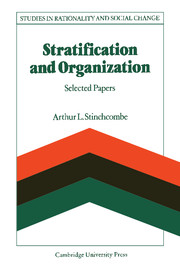Book contents
- Frontmatter
- Contents
- Acknowledgments
- 1 Rationality and social structure: an introduction
- PART I STRATIFICATION
- PART II ORGANIZATIONS
- 9 Bureaucratic and craft administration of production: a comparative study
- 10 Social structure and the founding of organizations
- 11 On social factors in administrative organization
- 12 Norms of exchange
- PART III SOCIOLOGY AS A PROFESSION
- Bibliography
- Name and place-name index
- Subject index
10 - Social structure and the founding of organizations
from PART II - ORGANIZATIONS
Published online by Cambridge University Press: 06 July 2010
- Frontmatter
- Contents
- Acknowledgments
- 1 Rationality and social structure: an introduction
- PART I STRATIFICATION
- PART II ORGANIZATIONS
- 9 Bureaucratic and craft administration of production: a comparative study
- 10 Social structure and the founding of organizations
- 11 On social factors in administrative organization
- 12 Norms of exchange
- PART III SOCIOLOGY AS A PROFESSION
- Bibliography
- Name and place-name index
- Subject index
Summary
This essay will be concerned with the implications of the fact that organizational forms and types have a history, and that this history determines some aspects of the present structure of organizations of that type. The organizational inventions that can be made at a particular time in history depend on the social technology available at the time. Organizations which have purposes that can be efficiently reached with the socially possible organizational forms tend to be founded during the period in which they become possible. Then, both because they can function effectively with those organizational forms, and because the forms tend to become institutionalized, the basic structure of the organization tends to remain relatively stable.
For example, the present urban construction industry, with specialized craft workers, craft-specialized subcontractors, craft trade unions, and a relation of contract between the construction enterprise and the consumer, was developed in European cities before the industrial revolution. Such an organization requires relatively dense settlement, some detachment of socialization for occupational rôles from families to be vested in guild-like organizations of craftsmen, contracts enforceable in the law, free wage labor which can move to some extent from job to job and employer to employer, and so on. Such conditions do not normally exist in agrarian societies. This craft form of organization has persisted partly because it is well adapted to the problems of the building industry and partly because of the force of tradition and vested interest, except in certain circumstances.
- Type
- Chapter
- Information
- Stratification and OrganizationSelected Papers, pp. 196 - 220Publisher: Cambridge University PressPrint publication year: 1986
- 2
- Cited by



